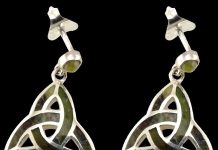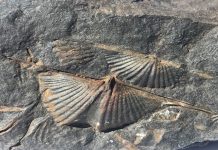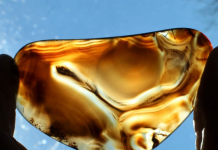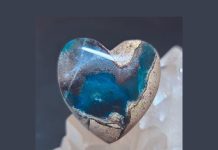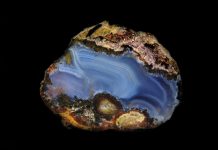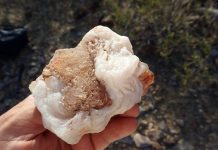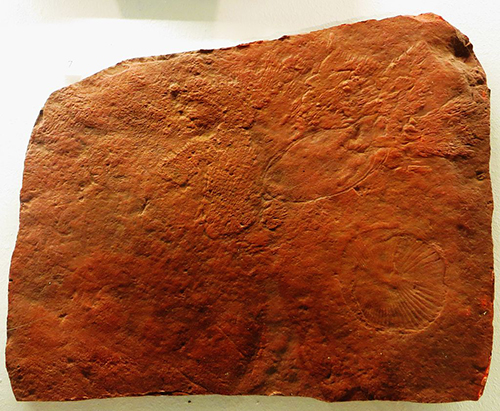
Editor’s Note: Enjoy this compilation of rock, gem, mineral-related news of the day.
By Jim Brace-Thompson
“Biomarkers” Establish One of Earth’s Earliest Animals
Not so long ago, when I was a mere lad, scientists relied upon hard parts (bone, teeth, shells) or physical impressions left in sedimentary rocks to study ancient life on Earth. Well, the times they are a-changin’.
Increasingly sophisticated chemical analyses are teasing ever more information from fossils and the sediments encasing them. Ever since the first Jurassic Park movie, the pursuit for ancient DNA has grabbed all the headlines, but equally intriguing pursuits have been underway.
Case in point: some of the oldest macroscopic complex organisms (i.e., large-bodied critters) are the so-called Ediacara biota. Such critters hail from Precambrian time 570 to 541 million years ago. They left strange impressions in rocks, and scientists have long debated just how they might be related to present-day plants and animals. In fact, they’ve debated whether the critters even were plants or animals—or something completely different.
Thanks to “biomarkers”, they now believe at least one Ediacara critter named Dickinsonia was definitely a metazoan, or an animal. Animals produce and use steroids, traces of which can live on in sediments encasing a fossil even after half a billion years. A team of scientists has extracted biomarkers indicating Dickinsonia produced cholesteroids, and—in the September 21 issue of the journal Science—they say their results “make these iconic members of the Ediacra biota the oldest confirmed macroscopic animals in the rock record”, pre-dating and perhaps leading to the “Cambrian explosion” of complex animal life on Earth.
The “Edmore Meteorite” Discovered as a Doorstop—and That’s No Joke!
So this guy buys this farm, and the seller asks, “You want a hot rock with that?” It sounds like the beginning of a bad barroom joke in search of a punchline, but this was no joke!
When David Mazurek bought a farm near Edmore, Michigan in 1988, the previous owner told him that the 22.5 pound rock being used as a doorstop was a meteorite from the 1930s; in fact, he and his sons had dug it up from a crater when it was still smoking-hot after enduring a loud racket the night before. Ha, ha! Good joke! Well, after 30 years, during which time his kids dragged the rock to school for show-and-tell, David finally decided to check it out.
Central Michigan University geology professor Mona Sirbescu ran a few tests for him and sent a couple slices to the Smithsonian, which found Widmanstätten patterns, or hallmark crystal formations unique to iron-nickel meteorites. The punchline? That doorstop is indeed a 4-billion-year-old meteorite, only the twelfth one to be confirmed from the state of Michigan, and one that has been valued to the tune of $100,000. Like I said, no joke!
Strange Times on Geyser Hill…
Yellowstone National Park is known for its geysers, most famously Old Faithful, which erupts on such a regular cycle you could almost set your watch by it. But Yellowstone also hosts shy geysers, like Ear Spring on Geyser Hill.
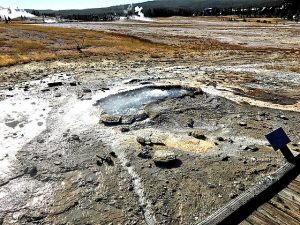
Normally an ear-shaped pool of boiling water, Ear Spring has erupted as a geyser only one or two times per decade, sending a wimpy little gush a couple feet into the air. In fact, the last time it put on a really good show was in 1957. That changed on September 15 as it shot a 20- to 30-foot column of water and steam, giving visitors quite a thrill. Not so thrilling is what accompanied all that steam as Ear Spring vented.
Park rangers try to keep visitors on posted boardwalks and urge folks to pack out what they pack in. Apparently, not all have headed that advice over the years. When Ear Spring belched, out came several dozen man-made objects including a cinder block, shoe heal, drinking straw, beer cans, “good-luck” coins, and a vintage pacifier from the 1930s. Rangers apparently are not amused, saying, “The next time Ear Spring erupts we hope it’s nothing but natural rocks and water.”
Author: Jim Brace-Thompson
 Founder and overseer of the AFMS Badge Program for kids.
Founder and overseer of the AFMS Badge Program for kids.
He’s also an inductee of the National Rockhound & Lapidary Hall of Fame within the Education Category.



